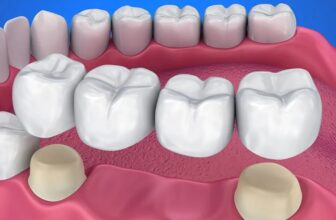
Teeth whitening gels are popular for achieving a brighter, more radiant smile. They work through a chemical process that targets the stains and discolouration on your teeth. Understanding the science behind these gels can help you make informed choices about your whitening options and achieve the best results. Here’s a detailed look at how teeth-whitening gels work and the science behind their effectiveness.
Key Ingredients in Teeth Whitening Gels
- Hydrogen Peroxide
- Active Ingredient: Hydrogen peroxide is one of the most common active ingredients in teeth whitening gels. It acts as a bleaching agent that helps to break down stains and discolouration on the teeth.
- Oxidation Process: When hydrogen peroxide comes into contact with the surface of your teeth, it releases oxygen molecules. These oxygen molecules penetrate the enamel and dentin, breaking down the pigments and stains into smaller, less noticeable particles through an oxidation process.
- Carbamide Peroxide
- Secondary Ingredient: Carbamide peroxide is another common ingredient in teeth-whitening gels. When applied to teeth, it breaks down into hydrogen peroxide.
- Slow Release: Carbamide peroxide provides a slower, more controlled release of hydrogen peroxide, making it suitable for at-home whitening treatments. It tends to be less aggressive compared to hydrogen peroxide alone.
- Whitening Agents
- Additional Components: Some gels may include additional whitening agents or stabilizers to enhance the effectiveness of the primary ingredients. These may consist of sodium bicarbonate (baking soda) or potassium nitrate, which can aid in stain removal and reduce tooth sensitivity.
How Teeth Whitening Gels Work
- Application Process
- Gel Application: Teeth whitening gels are typically applied directly to the surface of the teeth using trays, strips, or brushes. The gel is designed to remain in contact with the teeth for a specified period to allow the active ingredients to work effectively.
- Enamel Penetration: Once applied, the gel’s active ingredients penetrate the enamel (the outer layer of the teeth) and reach the dentin (the layer beneath the enamel). This penetration is essential for breaking down the deeper stains that may not be visible on the surface.
- Chemical Reaction
- Oxidation: The primary chemical reaction involved in teeth whitening is oxidation. Hydrogen or carbamide peroxide releases oxygen molecules that interact with the stain molecules. This interaction breaks the chemical bonds holding the stain pigments, resulting in a lighter tooth colour.
- Decomposition of Stains: The decomposition of stains reduces their visibility, making the teeth appear whiter. The process can be gradual, with visible results typically occurring after several treatments.
- Whitening Effectiveness
- Stain Removal: Teeth whitening gels effectively remove various stains, including those caused by food, beverages, tobacco, and aging. The effectiveness can vary depending on the type and severity of the stains.
- Enamel Safety: Most teeth whitening gels are designed to be safe for enamel when used as directed. However, overuse or improper application can lead to enamel erosion or increased tooth sensitivity. Following the recommended usage guidelines helps ensure safety and effectiveness.
Factors Influencing Whitening Results
- Initial Tooth Color
- Baseline Shade: The starting colour of your teeth can impact the final results. Naturally, darker or more stained teeth may require more treatments to achieve the desired level of whiteness.
- Stain Type
- Surface vs. Deep Stains: Surface stains caused by dietary habits are generally easier to remove than deep stains that have penetrated the enamel. Whitening gels are more effective on surface stains, but deeper discoloration may require additional treatments.
- Product Strength
- Concentration Levels: The concentration of hydrogen peroxide or carbamide peroxide in the whitening gel affects its effectiveness. Higher concentrations generally yield faster and more noticeable results but may also increase the risk of sensitivity.
- Usage Frequency
- Consistency: Regular whitening gels, as directed, contribute to achieving and maintaining the best results. Inconsistent use can delay or diminish the whitening effects.
Managing Side Effects
- Tooth Sensitivity
- Possible Sensitivity: Some users may experience tooth sensitivity during or after whitening treatments. This is often temporary and can be managed by desensitizing toothpaste or reducing its frequency of use.
- Gum Irritation: If the whitening gel comes into contact with the gums, it may irritate. Using a properly fitted tray and avoiding overuse can help prevent gum issues.
- Enamel Health
- Protecting Enamel: To protect enamel, follow the product’s guidelines and avoid excessive use. Maintaining good oral hygiene and using fluoride treatments can also help strengthen enamel.
Conclusion
teeth whitening in Sinhagad Road offers an effective way to brighten your smile through a scientifically based chemical process. By understanding the ingredients and mechanisms involved, you can make informed decisions about your whitening treatments and achieve a whiter smile safely and effectively. Remember to follow the usage instructions and consult your dentist if you have any concerns or experience adverse effects. You can enjoy the benefits of a brighter, more confident smile with proper care and the right approach.







